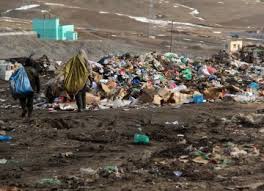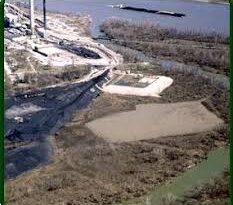Definition, Forms and Sources of Pollution Abatement and Control
It was the industrial revolution that gave birth to environmental pollution as we know it today. The emergence of great factories and consumption of immense quantities of coal and other fossil fuels gave rise to unprecedented air pollution and the large volume of industrial chemical discharges added to the growing load of untreated human waste.
The emergence of big towns/cities and population explosion have contributed immensely to the problems of pollution in most developing countries. In this unit we shall be talking about the concept of pollution abatement and control.
Concept of Pollution Control and Abatement
Pollution is the introduction of contaminants into the natural environment that causes adverse change. Pollution can take the form of chemical substances or energy, such as noise, heat or light. Pollutants, the components of pollution, can be either foreign substances/energies or naturally occurring contaminants.
Pollution is often classed as point source or nonpoint source pollution. The Blacksmith Institute issues an annual list of the world’s worst polluted places. In the 2007 issues the ten top nominees are located in Azerbaijan, China, India, Peru, Russia, Ukraine and Zambia.
Pollution abatement refers to technology applied or measure taken to reduce pollution and/or its impacts on the environment. The most commonly used technologies are scrubbers, noise mufflers, filters, incinerators, wastewater treatment facilities and composting of wastes.
The cost of substantially reducing industrial pollution is high; how to finance it without undue economic burden remains a question. Some experts hold that since population growth automatically increases waste production, pollution can best be combated by population control.
Read Also: The Economic Impact of Pollution
Another view is that worldwide proliferation of industry and technology is the chief culprit, posing the threat of global warming and requiring curtailment if pollution is to be conquered. The early 1990s brought discussion of more effective means to calculate the true costs of pollution in terms of its effects on health, productivity, and quality of life.
There is considerable agreement, nonetheless, on the need for revised technology to diminish industrial and automotive emissions, to produce degradable wastes, and to dispose of all wastes in ways less damaging to the environment—for example, by returning sewage to the farm as fertilizer and by recycling glass and metal materials.
Finally, improvement is required in techniques for preventing pollution by especially hazardous wastes. The difficulty of finding adequate permanent storage locations has been increased by opposition from residents of potential sites, who are concerned about health hazards.
In 1997 more than 1.3 million people in the United States were employed in environmental industries related to pollution control.
Air pollution has always accompanied civilizations. Pollution started from the prehistoric times when man created the first fires. According to a 1983 article in the journal Science, “soot found on ceilings of prehistoric caves provides ample evidence of the high levels of pollution that was associated with inadequate ventilation of open fires.
The forging of metals appears to be a key turning point in the creation of significant air pollution levels outside the home. Core samples of glaciers in Greenland indicate increases in pollution associated with Greek, Roman and Chinese metal production, but at that time the pollution was comparatively less and could be handled by nature.
Historical perspective – King Edward 1 of England banned the burning of sea-coal by proclamation in London in 1272, after its smoke became a problem. But the fuel was so common in England that this earliest of names for it was acquired because it could be carted away from some shores by the wheelbarrow.
Air pollution would continue to be a problem in England, especially later during the industrial revolution, and extending into the recent past with the Great Smog of 1952. London also recorded one of the earlier extreme cases of water quality problems with the Great Stink on the Thames of 1858, which led to construction of the London sewerage system soon afterward.
Chicago and Cincinnati were the first two American cities to enact laws ensuring cleaner air in 1881. Other cities followed around the country until early in the 20th century, when the short lived Office of Air Pollution was created under the Department of the Interior. Extreme smog events were experienced by the cities of Los Angeles and Donora, Pennsylvania in the late 1940s, serving as another public reminder.
Later Development – Pollution became a popular issue after World War II, due to radioactive fallout from atomic warfare and testing. Then a non-nuclear event, The Great Smog of 1952 in London, killed at least 4000 people. This prompted some of the first major modern environmental legislation, The Clean Air Act of 1956.
Pollution began to draw major public attention in the United States between the mid-1950s and early 1970s, when Congress passed the Noise Control Act, the Clean Air Act, the Clean water Act and the National Environmental Policy Act.
Incidences: Severe incidents of pollution helped increase consciousness. PCB dumping in the Hudson River resulted in a ban by the EPA on consumption of its fish in 1974. Long-term dioxin contamination at Love Canal starting in 1947 became a national news story in 1978 and led to the Superfund legislation of 1980.
Legal proceedings in the 1990s helped bring to light hexavalent chromium releases in California–the champions of whose victims became famous. The pollution of industrial land gave rise to the name brown-field, a term now common in city planning.
Nuclear science: The development of nuclear science introduced radioactive contamination, which can remain lethally radioactive for hundreds of thousands of years. Lake karachay, named by the World- watch Institute as the “most polluted spot” on earth, served as a disposal site for the Soviet Union throughout the 1950s and 1960s. Second place may go to the area of Chelyabinsk U.S.S.R. (see reference below) as the “Most polluted place on the planet.
Nuclear weapons continued to be tested in the Cold War, sometimes near inhabited areas, especially, in the earlier stages of their development. The toll on the worst-affected populations and the growth since then in understanding about the critical threat to human health posed by radioactivity has also been a prohibitive complication associated with nuclear power.
Though extreme care is practiced in that industry, the potential for disaster suggested by incidents such as those at Three Mile Island and Chernobyl pose a lingering specter of public mistrust. One legacy of nuclear testing before most forms were banned has been significantly raised levels of background radiation.
Catastrophes: International catastrophes such as the wreck of the Amoco Cadiz oil tanker off the coast of Brittany in 1978 and the Bhopal disaster in 1984 have demonstrated the universality of such events and the scale on which efforts to address them needed to engage. The borderless nature of atmosphere and oceans inevitably resulted in the implication of pollution on a planetary level with the issue of global warming.
Most recently the term Persistent Organic Pollutants (POP) has come to describe a group of chemicals such as PBDEs and PFCs among others. Though their effects remain somewhat less well understood owing to a lack of experimental data, they have been detected in various ecological habitats far removed from industrial activity such as the Arctic, demonstrating diffusion and bioaccumulation after only a relatively brief period of widespread use.
Growing evidences – Growing evidence of local and global pollution and an increasingly informed public over time have given rise to environmentalism and the environmental movement, which generally seek to limit human impact on the environment.
Forms of Pollution
The major forms of pollution are listed below along with the particular contaminant relevant to each of them:
Air pollution: the release of chemicals and particulates into the atmosphere. Common gaseous pollutants include carbon monoxide, sulphur dioxide, chlorofluorocarbons (CFCs) and nitrogen oxides produced by industry and motor vehicles.
Photochemical ozone and smog are created as nitrogen oxides and hydrocarbons react to sunlight. Particulate matter, or fine dust is characterized by their micrometre size PM10 to PM2.5.

Light pollution: includes light trespass, over-illumination and astronomical interference. Littering: the criminal throwing of inappropriate man-made objects, onto public and private properties.
Noise pollution: which encompasses roadway noise, aircraft noise, industrial noise as well as high-intensity sonar.
Soil contamination: occurs when chemicals are released by spill or underground leakage. Among the most significant soil contaminants are hydrocarbons, heavy metals, MTBE, herbicides, pesticides and chlorinated hydrocarbons.
Radioactive contamination, resulting from 20th century activities in atomic physics, such as nuclear power generation and nuclear weapons research, manufacture and deployment. (See alpha emitters and actinides in the environment).
Thermal pollution: is a temperature change in natural water bodies caused by human influence, such as use of water as coolant in a power plant.
Visual pollution: which can refer to the presence of overhead power lines, motorway billboards, scarred landforms (as from strip mining), open storage of trash, municipal solid waste or space debris.
Water pollution: by the discharge of wastewater from commercial and industrial waste (intentionally or through spills) into surface waters; discharges of untreated domestic sewage, and chemical contaminants, such as chlorine, from treated sewage; release of waste and contaminants into surface runoff flowing to surface waters (including urban runoff and agricultural runoff, which may contain chemical fertilizers and pesticides); waste disposal and leaching into groundwater; eutrophication and littering.
Sources and Causes of Pollution
Air pollution produced by ships may alter clouds, affecting global temperatures (Figure 1.2). Air pollution comes from both natural and human-made (anthropogenic) sources. However, globally human-made pollutants from combustion, construction, mining, agriculture and warfare are increasingly significant in the air pollution equation.
Motor vehicle emissions are one of the leading causes of air pollution. China, United States, Russia, Mexico, and Japan are the world leaders in air pollution emissions.
Principal stationary pollution sources include chemical plants, coal-fired power plants, oil refineries, petrochemical plants, nuclear waste disposal activity, incinerators, large livestock farms (dairy cows, pigs, poultry, etc.), PVC factories, metals production factories, plastics factories, and other heavy industry. Agricultural air pollution comes from contemporary practices which include clear felling and burning of natural vegetation as well as spraying of pesticides and herbicides.
About 400 million metric tons of hazardous wastes are generated each year. The United States alone produces about 250 million metric tons. Americans constitute less than five per cent of the world’s population, but produce roughly 25 per cent of the world‘s CO2, and generate approximately 30 per cent of world‘s waste.
In 2007, China has overtaken the United States as the world’s biggest producer of CO2, while still far behind based on per capita pollution – ranked 78th among the world’s nations.
In February 2007, a report by the Intergovernmental Panel on Climate Change (IPCC), representing the work of 2,500 scientists, economists, and policymakers from more than 120 countries, said that humans have been the primary cause of global warming since 1950.
Read Also: Policy and Legislation Measures on Pollution Control
Humans have ways to cut greenhouse gas emissions and avoid the consequences of global warming, a major climate report concluded. But to change the climate, the transition from fossil fuels like coal and oil needs to occur within decades, according to the final report this year from the UN’s Intergovernmental Panel on Climate Change (IPCC).
Some of the more common soil contaminants are chlorinated hydrocarbons (CFH), heavy metals (such as chromium, cadmium–found in rechargeable batteries, and lead–found in lead paint, aviation fuel and still in some countries, gasoline), MTBE, zinc, arsenic and benzene.
In 2001 a series of press reports culminating in a book called Fateful Harvest unveiled a widespread practice of recycling industrial by- products into fertilizer, resulting in the contamination of the soil with various metals.
Ordinary municipal landfills are the source of many chemical substances entering the soil environment (and often groundwater), emanating from the wide variety of refuse accepted, especially substances illegally discarded there, or from pre-1970 landfills that may have been subject to little control in the US or EU. There have also been some unusual releases of polychlorinated dibenzodioxins, commonly called dioxins for simplicity, such as TCDD.
Pollution can also be the consequence of a natural disaster. For example, hurricanes often involve water contamination from sewage, and petrochemical spills from ruptured boats or automobiles. Larger scale and environmental damage is not uncommon when coastal oil rigs or refineries are involved. Some sources of pollution, such as nuclear power plants or oil tankers, can produce widespread and potentially hazardous releases when accidents occur.
In the case of noise pollution the dominant source class is the motor vehicle, producing about ninety per cent of all unwanted noise worldwide.
Effects on Human Health

Overview of main health effects on humans from some common types of pollution. Adverse air quality can kill many organisms including humans. Ozone pollution can cause respiratory disease, cardiovascular disease, throat inflammation, chest pain, and congestion. Water pollution causes approximately 14,000 deaths per day, mostly due to contamination of drinking water by untreated sewage in developing countries.
An estimated 700 million Indians have no access to a proper toilet, and 1,000 Indian children die of diarrhoeal sickness every day. Nearly 500 million Chinese lack access to safe drinking water. 656,000 people die prematurely each year in China because of air pollution. In India, air pollution is believed to cause 527,700 fatalities a year. Studies have estimated that the number of people killed annually in the US could be over 50,000.
Oil spills can cause skin irritations and rashes. Noise pollution induces hearing loss, high blood pressure, stress, and sleep disturbance. Mercury has been linked to developmental deficits in children and neurologic symptoms.
Older people are majorly exposed to diseases induced by air pollution. Those with heart or lung disorders are under additional risk. Children and infants are also at serious risk. Lead and other heavy metals have been shown to cause neurological problems. Chemical and radioactive substances can cause cancer and as well as birth defects.
Effects on Environment
Pollution has been found to be present widely in the environment. There are a number of effects of this:
Biomagnification describes situations where toxins (such as heavy metals) may pass through trophic levels, becoming exponentially more concentrated in the process.
Carbon dioxide emissions cause ocean acidification, the ongoing decrease in the pH of the Earth’s oceans as CO2 becomes dissolved.
The emission of greenhouse gases leads to global warming which affects ecosystems in many ways.
Invasive species can compete with native species and reduce biodiversity. Invasive plants can contribute debris and biomolecules (allelopathy) that can alter soil and chemical compositions of an environment, often reducing native species competitiveness.
Nitrogen oxides are removed from the air by rain and fertilize land which can change the species composition of ecosystems.
Smog and haze can reduce the amount of sunlight received by plants to carry out photosynthesis and leads to the production of tropospheric ozone which damages plants.
Soil can become infertile and unsuitable for plants. This will affect other organisms in the food web.
Sulphur dioxide and nitrogen oxides can cause acid rain which lowers the pH value of soil.



